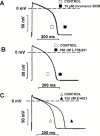Pharmacological block of the slow component of the outward delayed rectifier current (I(Ks)) fails to lengthen rabbit ventricular muscle QT(c) and action potential duration
- PMID: 11156566
- PMCID: PMC1572535
- DOI: 10.1038/sj.bjp.0703777
Pharmacological block of the slow component of the outward delayed rectifier current (I(Ks)) fails to lengthen rabbit ventricular muscle QT(c) and action potential duration
Abstract
1. The effects of I(Ks) block by chromanol 293B and L-735,821 on rabbit QT-interval, action potential duration (APD), and membrane current were compared to those of E-4031, a recognized I(Kr) blocker. Measurements were made in rabbit Langendorff-perfused whole hearts, isolated papillary muscle, and single isolated ventricular myocytes. 2. Neither chromanol 293B (10 microM) nor L-735,821 (100 nM) had a significant effect on QTc interval in Langendorff-perfused hearts. E-4031 (100 nM), on the other hand, significantly increased QTc interval (35.6+/-3.9%, n=8, P<0.05). 3. Similarly both chromanol 293B (10 microM) and L-735,821 (100 nM) produced little increase in papillary muscle APD (less than 7%) while pacing at cycle lengths between 300 and 5000 ms. In contrast, E-4031 (100 nM) markedly increased (30 - 60%) APD in a reverse frequency-dependent manner. 4. In ventricular myocytes, the same concentrations of chromanol 293B (10 microM), L-735,821 (100 nM) and E-4031 (1 microM) markedly or totally blocked I(Ks) and I(Kr), respectively. 5. I(Ks) tail currents activated slowly (at +30 mV, tau=888.1+/-48.2 ms, n=21) and deactivated rapidly (at -40 mV, tau=157.1+/-4.7 ms, n=22), while I(Kr) tail currents activated rapidly (at +30 mV, tau=35.5+/-3.1 ms, n=26) and deactivated slowly (at -40 mV, tau(1)=641.5+/-29.0 ms, tau(2)=6531+/-343, n=35). I(Kr) was estimated to contribute substantially more to total current density during normal ventricular muscle action potentials (i.e., after a 150 ms square pulse to +30 mV) than does I(Ks). 6. These findings indicate that block of I(Ks) is not likely to provide antiarrhythmic benefit by lengthening normal ventricular muscle QTc, APD, and refractoriness over a wide range of frequencies.
Figures







Similar articles
-
Restricting excessive cardiac action potential and QT prolongation: a vital role for IKs in human ventricular muscle.Circulation. 2005 Sep 6;112(10):1392-9. doi: 10.1161/CIRCULATIONAHA.105.550111. Epub 2005 Aug 29. Circulation. 2005. PMID: 16129791
-
The role of the delayed rectifier component IKs in dog ventricular muscle and Purkinje fibre repolarization.J Physiol. 2000 Feb 15;523 Pt 1(Pt 1):67-81. doi: 10.1111/j.1469-7793.2000.00067.x. J Physiol. 2000. PMID: 10675203 Free PMC article.
-
Effect of a neuroprotective drug, eliprodil on cardiac repolarisation: importance of the decreased repolarisation reserve in the development of proarrhythmic risk.Br J Pharmacol. 2004 Sep;143(1):152-8. doi: 10.1038/sj.bjp.0705901. Epub 2004 Aug 9. Br J Pharmacol. 2004. PMID: 15302678 Free PMC article.
-
Pharmacological modulation of I(Ks): potential for antiarrhythmic therapy.Curr Med Chem. 2004 Jan;11(1):29-44. doi: 10.2174/0929867043456214. Curr Med Chem. 2004. PMID: 14754424 Review.
-
Profile of I(Ks) during the action potential questions the therapeutic value of I(Ks) blockade.Curr Med Chem. 2004 Jan;11(1):45-60. doi: 10.2174/0929867043456304. Curr Med Chem. 2004. PMID: 14754425 Review.
Cited by
-
Diclofenac prolongs repolarization in ventricular muscle with impaired repolarization reserve.PLoS One. 2012;7(12):e53255. doi: 10.1371/journal.pone.0053255. Epub 2012 Dec 31. PLoS One. 2012. PMID: 23300901 Free PMC article.
-
Sex differences in repolarization and slow delayed rectifier potassium current and their regulation by sympathetic stimulation in rabbits.Pflugers Arch. 2013 Jun;465(6):805-18. doi: 10.1007/s00424-012-1193-9. Epub 2012 Dec 15. Pflugers Arch. 2013. PMID: 23242028 Free PMC article.
-
A Comparative Study of the Rapid (IKr) and Slow (IKs) Delayed Rectifier Potassium Currents in Undiseased Human, Dog, Rabbit, and Guinea Pig Cardiac Ventricular Preparations.Pharmaceuticals (Basel). 2024 Aug 20;17(8):1091. doi: 10.3390/ph17081091. Pharmaceuticals (Basel). 2024. PMID: 39204196 Free PMC article.
-
Slow delayed rectifier potassium current (IKs) and the repolarization reserve.Ann Noninvasive Electrocardiol. 2007 Jan;12(1):64-78. doi: 10.1111/j.1542-474X.2007.00140.x. Ann Noninvasive Electrocardiol. 2007. PMID: 17286653 Free PMC article. Review.
-
Beta-adrenergic stimulation reverses the I Kr-I Ks dominant pattern during cardiac action potential.Pflugers Arch. 2014 Nov;466(11):2067-76. doi: 10.1007/s00424-014-1465-7. Epub 2014 Feb 19. Pflugers Arch. 2014. PMID: 24535581 Free PMC article.
References
-
- ANYUKHOVSKY E.P., SOSUNOV E.U., GAINULLIN R.Z., ROSEN M.R. The controversial M cell. J. Cardiovasc. Electrophysiol. 1999;10:244–260. - PubMed
-
- BENNET P.B., BEGENISCH T.B. Catecholamines modulate the delayed rectifying potassium current (IK) in guinea pig ventricular myocytes. Pflugers Archiv-Eur. J. Physiol. 1987;410:212–219. - PubMed
-
- BILLMAN G.E., HOULE M.S., LYNCH J.J. Selective IKs blockade protects against ventricular fibrillation induced by myocardial ischaemia. Eur Heart J. 1998a;19 Abs. Suppl.:17.
-
- BILLMAN G.E., HOULE M.S., LYNCH J.J. Selective IKs but not IKr blockade protects against ventricular fibrillation induced by myocardial ischaemia. Circulation. 1998b;98:1–52. - PubMed
-
- BOSCH R.F., GASPO R., BUSCH A.E., LANG H.J., LI G.R., NATTEL S. Effects of the chromanol 293B, a selective blocker of the slow component of the delayed rectifier K+ current on repolarization in human and guinea pig ventricular myocytes. Cardiovasc Res. 1998;38:441–450. - PubMed
Publication types
MeSH terms
Substances
LinkOut - more resources
Full Text Sources
Other Literature Sources

